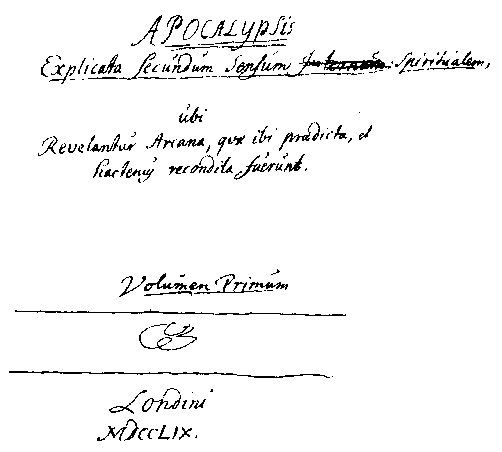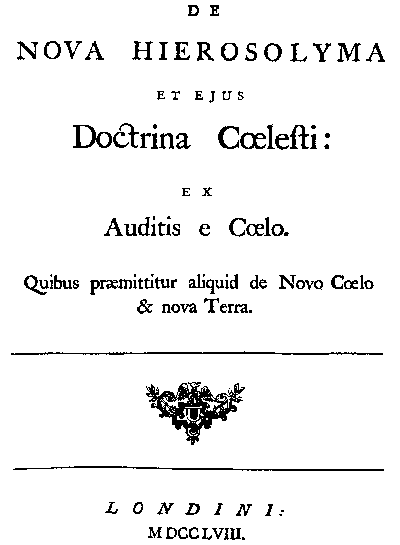Jonathan S. Rose, M.Div., Ph.D.
Swedenborg's Role
Two significant questions remain. Is Swedenborg likely to have had a say in where the ornaments appeared or were they just something the printer inserted? And is it at all possible that Swedenborg drew and/or engraved all or any of these ornaments himself?
There
is evidence that Swedenborg took great care in his publishing process.
Usually when he published his theological works he traveled abroad and
took up lodgings near the printer. Only in the case of the last seven
volumes of Arcana Coelestia did he publish without being near the
printer. So he was usually present, available to, and presumably interacting
with the printer throughout the publishing process.
There is solid evidence that Swedenborg determined not only the font sizes and styles of his publications but also the ornamentation and layout of his title pages. That evidence takes the form of Swedenborg's "fair" autograph manuscript of Apocalypse Explained, the only fair copy of his to survive. Swedenborg gave it a title page under whose title there is a full width line, then two smaller curving lines that loop around centered on the page followed by another full width line under which he wrote the projected place and date of publication (London 1759). It is very much a handwritten equivalent, albeit drawn rather quickly, of the ornamented title pages published in London (see reproductions below) with their full width lines above and below a centered ornament.
 |
|
Reproduction
of Swedenborg's handwritten "fair copy"
title page of Apocalypse Explained. |
Furthermore
in the ensuing text of the fair copy of Apocalypse Explained Swedenborg
wrote directions to the printer vertically in the margins—"English
Roman" and "Pica Roman"—to show which font type and
size (fourteen and twelve point respectively) he wanted for each section
of the text. The fair copy demonstrates then that Swedenborg did not leave
decisions about the layout or presence of ornamentation on his title pages,
nor about fonts and type sizes, to the printer. This combined with the
consistent use of ornamentation throughout every volume convinces me that
Swedenborg wanted his first editions to look the way they do.
 |
|
Reproduction
of the published title page of Swedenborg's
New Jerusalem and its Heavenly Doctrine. |
As
to whether the ornaments could have been produced by Swedenborg himself
there are arguments for and against. Swedenborg was clearly capable of
drawing and engraving beautiful ornaments himself. We know that as a younger
man he lived with an engraver and learned his trade as he had done with
other trades.9 In Daedalus
Hyperboreus, Swedenborg's joint publishing venture with his mentor
Christopher Polhem and the first scientific journal in Sweden, we find
Swedenborg's beautiful engravings of his own inventions. The evidence
that they were his own work is that whereas one plate of an invention
by Polhem gives the names of both the artist and the engraver in the lower
corners the engravings of Swedenborg's inventions appear with no names
in the corners; and the writing of his name bears a striking resemblance
to his own signature. These engravings are not of the same highly polished
quality as the one with names attached but are nonetheless skillfully
and artistically done.
In addition to skill and talent he may have also had a financial motivation to produce his own ornaments. Although the major type founders produced some stock ornaments individual publishers would generally commission engravers to produce custom artwork. Any author would of course want particularly the more significant ornaments such as title page ornaments and opening headpieces to be unique to their work. Yet high quality original engravings were a significant artform, as Rembrandt's reputation attests, and will therefore have been costly. I find that the most heavily decorated works in Swedenborg's library are generally ones that had a patron. Swedenborg's penchant for ornamentation may have exceeded his resources unless he engraved them himself. On the other hand it is hard to imagine Swedenborg having the time to do such an array of engravings; it would have been less time consuming for him to use the printer's stock or commission an artist to produce new engravings. There is the further possibility that Swedenborg created drawings and then paid someone else to engrave them, as I think he did for the tables in his Principia (Dresden and Leipzig 1734). Two of the tailpieces were clearly not engraved by Swedenborg: Tailpieces 08 and 09 have the letters "I B" on them, which will have been the engraver's initials.
My opinion has vascillated on whether Swedenborg produced these ornaments himself or not. At times I find the medium grade quality of the artwork itself a strong argument in favor of his having done them. But at other times I see more variety and less consistency in the ornaments' artistry. Here I leave the issue of artistic style to those better qualified to judge.
The
strongest argument against Swedenborg's having produced these ornaments
(or most of them at any rate) is the great divide from city to city. Nothing
but asterisks and a vague similarity between London's Tailpiece 05 and
Amsterdam's Tailpieces 20 and 27 link the ornaments from the two cities.
As stated above, no initials appear in London publications. There is repetition
and ornamental linkage between different works done in London and between
different works done in Amsterdam but none across the channel of time
and water between the two. Perhaps Swedenborg produced new ornaments in
the five years between 1758 and 1763 for the Amsterdam publications. But
why then did Intercourse between the Soul and Body, published surprisingly
in London eleven years after the switch to Amsterdam, end with a tailpiece
that occurred much earlier in other London publications, Arcana Coelestia
and New Jerusalem and its Heavenly Doctrine, rather than one from
Amsterdam? The ornaments apparently stayed with the printer rather than
following Swedenborg from one city to the other.
Now
perhaps his trunk was too full, the ornaments too heavy, bulky, or costly
to ship across the channel. The only two times I know of that Swedenborg
mentions engravings in connection with his own work both occur with the
phrase "in England." In his Journal of Dreams Swedenborg
relates two dreams of engravings and decoration that he takes as possible
guidance to create physical engravings.
There were certain who admired my copper prints, which were well done, and wished to see my rough draft, as if I was able to conceive them just as they were finished. It may mean that my work wins approbation, and they believe that I am not the doer of it. There came to hand a little letter, for which I paid nine stivers. When I opened it there lay within it a great book containing clean blank paper, and among this a great many lovely drawings: the rest, blank paper. There sat a woman on the left hand; then she removed to the right and turned over the leaves, and then drawings or designs came forth. It seemed that the meaning of the letter was that I should cause a number of such designs or patterns to be engraved in England. The woman had a rather broad bust and on both sides down to the lower parts was quite bare; the skin, shining as if it were polished; and on the thumb a miniature painting. This may perhaps mean that with God's help while in England I shall be enabled to carry out a number of beautiful designs for my work . . .10
The
wording does not settle whether he was thinking of making these engravings
himself or not. He speaks of "my copper prints," but then again
talks of himself "causing designs or patterns to be engraved,"
and later hopes that he will be "enabled to carry out" beautiful
designs. He puts his finger on the issue when he says that it may mean
people will believe he did not do the work. Either way, though, the passage
shows that Swedenborg was thinking of making or commissioning engravings
in England. Years later he may have done the same for engravings in Holland.
Most importantly, here we clearly see Swedenborg's, and possibly even
the other world's, concern for the beauty and ornamentation of his works.
It
is possible then that at least some of the ornaments are the handiwork
of Swedenborg himself. This possibility, his evident love for them, and
the clarity and distinctness of boundaries they provide make them worthy
of preservation.
I
have cast my eye over every book in Swedenborg's library as reconstructed
in the Swedenborg Library's Swedenborgiana collections. Swedenborg's large
decorated quarto volumes with their handsome type and generous margins
exceed most other volumes for beauty. A man who mentioned beauty almost
seven hundred times in publications on theology, who passionately loved
the theatre, who published two volumes of poetry, who bought a property
the size of a city block and commissioned workers with detailed instructions
to fill it with a large and magnificent garden, Swedenborg was a lover
of beauty. Whether he produced some engravings himself or not, whether
he exercised full control over which ornament went where, the ornaments
gave Swedenborg's theological first editions a beauty that later versions
have not had.
It seems a fitting conclusion (if an unusual use of a headpiece as a tailpiece) to end with a pretheological headpiece of Swedenborg's that starts the second part of The Infinite and Final Cause of Creation (1734). There are several great and well known portraits of Swedenborg. Could this be Swedenborg's portrait of himself?

First Page: Ornaments | Next Page: Endnotes